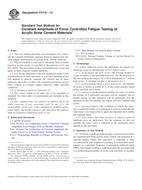Wir benötigen Ihre Einwilligung zur Verwendung der einzelnen Daten, damit Sie unter anderem Informationen zu Ihren Interessen einsehen können. Klicken Sie auf "OK", um Ihre Zustimmung zu erteilen.
ASTM F2118-10
Test Method for Constant Amplitude of Force Controlled Fatigue Testing of Acrylic Bone Cement Materials
Automatische name übersetzung:
Testverfahren für die konstante Amplitude von kraftgeregelten Ermüdungsprüfung von Acryl Bone Cement Baustoffe
NORM herausgegeben am 1.12.2010
Informationen über die Norm:
Bezeichnung normen: ASTM F2118-10
Anmerkung: UNGÜLTIG
Ausgabedatum normen: 1.12.2010
SKU: NS-52889
Zahl der Seiten: 17
Gewicht ca.: 51 g (0.11 Pfund)
Land: Amerikanische technische Norm
Kategorie: Technische Normen ASTM
Die Annotation des Normtextes ASTM F2118-10 :
Keywords:
acrylic bone cement, fatigue, fatigue life, Acrylic bone cement, Constant-amplitude axial tension-compression fatigue, Fatigue, ICS Number Code 91.100.10 (Cement. Gypsum. Lime. Mortar)
Ergänzende Informationen
| Significance and Use | ||||||||||
|
This test method describes a uniaxial, constant amplitude, fully reversed fatigue test to characterize the fatigue performance of a uniform cylindrical waisted specimen manufactured from acrylic bone cement. This test method considers two approaches to evaluating the fatigue performance of bone cement: Testing is conducted at three stress levels to characterize the general fatigue behavior of a cement over a range of stresses. The stress level and resultant cycles to failure of the specimens can plotted on an S-N diagram. Another approach is to determine the fatigue life of a particular cement. The fatigue life for orthopaedic bone cement is to be determined up to 5 million (5 × 106) cycles. This test method does not define or suggest required levels of performance of bone cement. This fatigue test method is not intended to represent the clinical use of orthopaedic bone cement, but rather to characterize the material using standard and well-established methods. The user is cautioned to consider the appropriateness of this test method in view of the material being tested and its potential application. It is widely reported that multiple clinical factors affect the fatigue performance of orthopaedic bone cement; however, the actual mechanisms involves multiple factors. Clinical factors which may affect the performance of bone cement include: temperature and humidity, mixing method, time of application, surgical technique, bone preparation, implant design, anatomical site, and patient factors, among others. This test method does not specifically address all of these clinical factors. The test method can be used to compare different acrylic bone cement formulations and products and different mixing methods and environments (that is, mixing temperature, vacuum, centrifugation, and so forth). |
||||||||||
| 1. Scope | ||||||||||
|
1.1 This test method describes test procedures for evaluating the constant amplitude, uniaxial, tension-compression uniform fatigue performance of acrylic bone cement materials. 1.2 This test method is relevant to orthopedic bone cements based on acrylic resins, as specified in Specification F451 and ISO 16402. The procedures in this test method may or may not apply to other surgical cement materials. 1.3 It is not the intention of this test method to define levels of performance of these materials. It is not the intention of this test method to directly simulate the clinical use of these materials, but rather to allow for comparison between acrylic bone cements to evaluate fatigue behavior under specified conditions. 1.4 A rationale is given in Appendix X2. 1.5 The values stated in SI units are to be regarded as standard. No other units of measurement are included in this standard. 1.6 This standard does not purport to address all of the safety concerns, if any, associated with its use. It is the responsibility of the user of this standard to establish appropriate safety and health practices and determine the applicability of regulatory limitations prior to use. |
||||||||||
| 2. Referenced Documents | ||||||||||
|
Empfehlungen:
Aktualisierung der technischen Normen
Wollen Sie sich sicher sein, dass Sie nur die gültigen technischen Normen verwenden?
Wir bieten Ihnen eine Lösung, die Ihnen eine Monatsübersicht über die Aktualität der von Ihnen angewandten Normen sicher stellt.
Brauchen Sie mehr Informationen? Sehen Sie sich diese Seite an.




 Cookies
Cookies
